She sent her mind elsewhere, across the Narrow Sea to Fécamp, to the massive church hard by her father’s great hall. She was five years old, and her mother was leading her to the side chapel, bidding her place her hand upon the marble plinth where an angel had once stood. He had appeared there in the year of Emma’s birth and had left behind the imprint of his foot in the stone. It had been worn even deeper since then, by the hands of the faithful that had touched it in reverence.
Chapter 39
Shadow on the Crown
The church described in the passage above is the Abbey Church of the Holy Trinity in Fecamp, Normandy. Founded by Emma’s father, Richard, the first Duke of Normandy, it was part of a large Benedictine abbey that would prosper until 1791 when the French Revolution caused its closure and the buildings were sold or destroyed. Now only the church remains.
I visited Holy Trinity in 2007. Much of the building dates back to the 13th century, but some of the foundation stones of the original church built by Richard I are still visible along one of the transepts. At least, that’s what I understood from my interpretation of the French guidebook I consulted.
Inside the abbey church I met a docent who pointed out a marble plinth with a hollow in its center. According to what she told me, the worn marble was the footprint of an angel. Here is the story:
In the year 990, around the time of the building of the church, there was some disagreement regarding its dedication. It needed a name. It needed a saint to watch over it. Who was it to be? One day a stranger – an angel – appeared in the church and placed a sword upon the altar. The sword was inscribed with the words “In the name of the Holy and Indivisible Trinity.” Whether the words were in French or Latin (perhaps Angelisc?) the legend does not say. At any rate, the angel left his footprint on the marble, and the church was dedicated to the Trinity. It is that bit of worn marble that Emma remembers near the end of my novel.
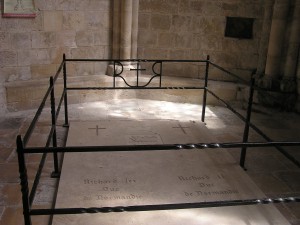 The tombs of Emma’s father and brother are located in a chapel in the south transept of the church. I do not believe that either duke was originally buried in this spot. Supposedly Richard I, at least, was given a Viking burial on a hilltop above Fécamp, in view of the sea. At some time, though, his body was brought inside the church, and now he lies beside his son.
The tombs of Emma’s father and brother are located in a chapel in the south transept of the church. I do not believe that either duke was originally buried in this spot. Supposedly Richard I, at least, was given a Viking burial on a hilltop above Fécamp, in view of the sea. At some time, though, his body was brought inside the church, and now he lies beside his son.
The two Richards also appear on the west front of the church, but the magnificent statues date from the 19th century, not the 11th. I can’t help thinking that these two men – warriors, descendants of Vikings, horsemen, and feared rulers of a vast territory – might, in real life, have dressed somewhat differently than they are depicted here.
……………………………………………………………………………………………………………………………………………………………………………………………………………… Holy Trinity boasts another miraculous relic in addition to the angel’s footprint: two vials of the Sacred Blood. The blood was collected by Nicodemus at the foot of Christ’s cross, then inserted into the trunk of a fig tree that washed up in the swampland of Fécamp. The relic has been the object of pilgrimage for centuries, justifying the size of the abbey church.
And the abbey church is indeed large. The nave is the same length as Notre-Dame, in Paris. The Lantern Tower at the crossing of the transept is typical of Norman Gothic architecture of the 11th century, allowing light to illuminate the center of the church. It’s a beautiful church, but of course what I was seeing in 2007 bore little resemblance to the church that Emma would have known in her father’s time. That would have been a smaller abbey church, surrounded by cloisters and gardens, dormitories, storehouses, perhaps a hostelry for pilgrims.
Emma never forgot Fecamp or the monks who dwelt there. She saw to it that the abbey was granted the port revenues and rents of the English town of Steyning, which lies directly across the Narrow Sea from Fécamp. Thus, the Benedictine abbey founded by a Norman duke became wealthy through the intercession of England’s Norman queen.
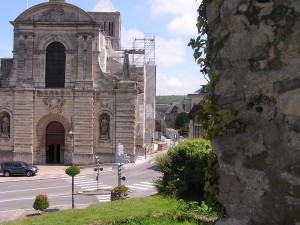
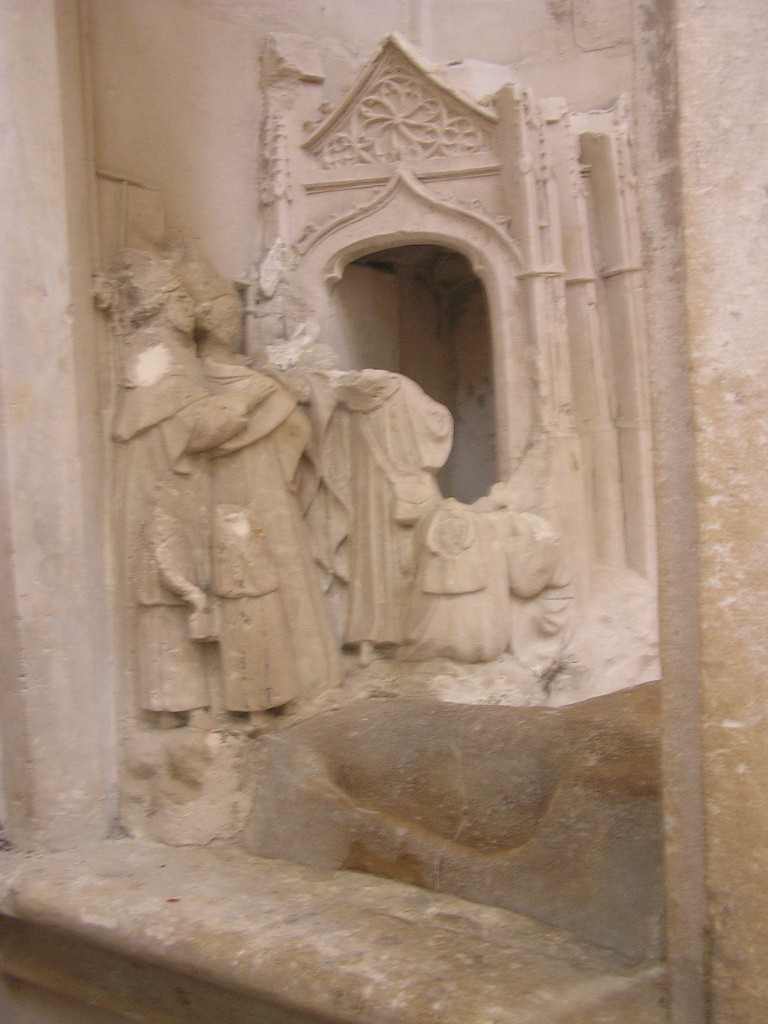
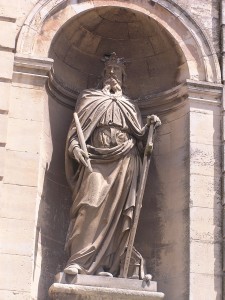
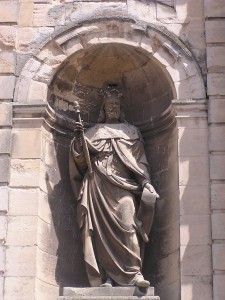
Hello, Mrs. Bracewell: I am about to read/(listen to) this book. I just downloaded it from the BARD website of http://www.loc.gov/nls. I suspect it should be very interesting. It’s a period of English history I know nothing about. I once read a book, Byzantium, and learned that in 1066 the English king had to fight Norway and then a few weeks later, the Normans, no wonder he lost! It amazes me how novelists can bring history alive. And you picked a unique segment of history. Everyone usually does the Tudors–probably to death–and even the 15th-century, not my favorite, Edward IV was strange. I think the 18th-century might need some really good explanation but you sure hit a unique nail on the head. Much success with your 2nd and 3rd books. My very best to you.
PS I hope someone does Temple of a Thousand Faces in audio–set in 12th-century Cambodia–it should be verry exotic. I like exotic! Oh, now I realize I could simply have emailed you. Drats! Best to you.
Dear Scopist65,
I’m very curious about your e-mail name. In Anglo-Saxon England (and in my book) a scop is a poet/singer. Pronounced SHOPE. The really brilliant actress who reads the audio book mis-pronounces the word, but probably I’m the only one who would know that. (And now you.) More and more writers are turning to unusual historical time periods to explore and re-create, and publishers are becoming more open to worlds other than that one inhabited by the Tudors. I hope you enjoy Shadow on the Crown. Thank you for your good wishes. Write to me again and tell me how you liked the book!
Hi Patricia, What shape is the tombs of Richard 1 & Richard 11 in now Fecamp Abbey? How many books about Emma of Normandy & Queen of England is there? Emma was aunt to Richard 111 & Robert ( father of William 1 of England )/ Richard 1 & Richard 11 of Normandy are my ancestors & Emma is my step greant grand mother who was the step mother of King Edmund Ironside of England ( my ancestor ). John
Hi John. There have been some pretty exciting things going on very recently at the tombs of the dukes in Fecamp. The tombs were opened a couple of weeks ago in order to examine the remains for DNA evidence indicating whether their forbear, Rollo, was from Norway or from Denmark. So you, as a descendant of the Richards, will learn if you are originally Norse or Danish as well. Supposedly the DNA of the royal families from these two countries is quite distinct, one from the other. You can read a news article about it at this site: http://www.thelocal.no/20160302/was-viking-ruler-rollo-danish-or-norwegian I presume that, having taken what they need from the tombs, the researches will put everything back where they found it, so the tombs should be in very good condition.
As for the number of books about Emma, there are my two novels, (I’m writing the third now); there is another novel by Helen Hollick, THE FOREVER QUEEN. There are two popular history books: EMMA THE TWICE-CROWNED QUEEN by Isabella Strachan; and QUEEN EMMA AND THE VIKINGS by Harriet O’Brien. Finally, the excellent and deeply researched biography of Emma was written by renowned medieval scholar Pauline Stafford: QUEEN EMMA & QUEEN EDITH, QUEENSHIP AND WOMEN’S POWER IN 11TH CENTURY ENGLAND. You should be able to find any or all of them.
What the connection here, if any, with St. Catherine’s monastery in Sinai?
Hi Paul. I do not know of any connection between Fecamp Abbey and St. Catherine’s in the Sinai.
Hi Patricia,
I am hoping to visit the Trinity Abbey Church next year after the Virus has gone away for good. Can you explain where I could find out exactly how that floating canopy structure in the Chancel was built. It seems to be suspended in mid air – floating almost. It appears to defy gravity.
How could people build such amazing shapes in the 12th Century? Have we lost those skills?
Laurie from New Zealand
Hi Laurie.
I hope you can visit Fecamp next year and that by then we’ll all have crawled out from beneath this pandemic! I have to confess that when I was inside Trinity Abbey Church my attention was almost completely focused on the earliest areas, especially the graves of Richard I and II, and the “Angel’s Footprint”. I didn’t look up much and I don’t even remember the canopy in the chancel. BUT I BOUGHT A BOOK! And my book says that the canopy is Baroque, added in the 18th century. And although it looks, in photos, like it’s suspended in mid-air, it is actually standing on marble pillars. Everything about that church is meant to draw the eyes up, to heaven. But there I was, looking down at the floor, searching for the angel’s footprint and for the outlines of the earliest church built by Emma’s father.